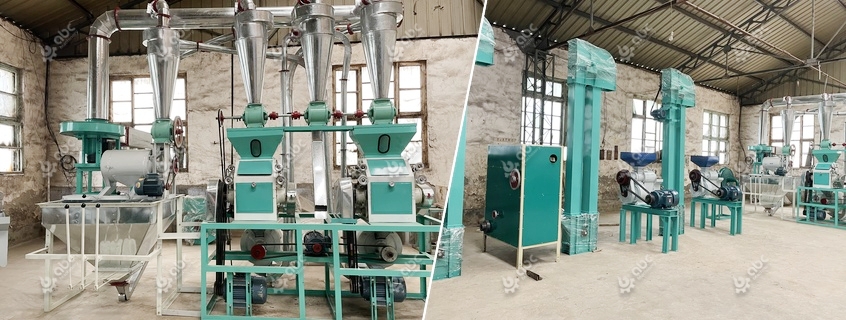
Corn Processing Plant Setup Step by Step Guide
The corn mill industry is one of the fastest-growing agro-industrial sectors, generating over $60 billion in annual global revenue. A corn processing plant plays a key role in transforming raw maize into high-value derivatives such as corn flour, starch, ethanol, and feed. According to 2024 FAO data, global corn utilization reached 1.16 billion tons, with processing accounting for more than 40% of total consumption.
Corn processing industry overview reports show that Asia-Pacific leads the market with 35% of global processing capacity, followed by North America and Europe. Demand for starch-based bioplastics and ethanol is projected to grow at 6.2% CAGR between 2025–2030, making corn processing investment increasingly attractive.
For investors and engineers, building a modern corn processing facility offers a profitable opportunity to enter a sustainable value chain that combines food, feed, and bioenergy sectors. Partner with our engineering experts to design a future-ready corn mill plant that maximizes output and return on investment.

100TPD Modern Corn Mill Engineering Success Project
Before launching a corn processing plant, a comprehensive feasibility study is essential. Raw material logistics should be analyzed first: a plant consuming 100 tons of corn per day typically requires suppliers within 50–70 km radius to minimize transport costs. Proximity to transportation infrastructure—railways, highways, or ports—can reduce logistics costs by up to 15%.
Site selection also depends on energy and water availability. A medium-scale factory consumes about 120 kWh of electricity and 0.6 m³ of water per ton of processed corn. Regions with stable power supply and affordable labor (average $8–12/hour) provide the most favorable setup environment.
Regulatory compliance is another key factor. Investors must assess environmental policies and wastewater discharge limits—many regions require total suspended solids (TSS) below 50 mg/L. Soil quality and flood risk should be evaluated during site surveying to ensure long-term operational stability.
Get expert guidance on feasibility analysis and location planning to secure optimal performance for your corn mill investment.
A well-designed corn processing plant layout ensures optimal product yield, energy efficiency, and workplace safety. The engineering corn milling process involves planning each step from cleaning and conditioning to grinding, separation, and drying.
The basic process begins with pre-cleaning (removing dust and impurities), followed by dehulling, wet or dry milling, separation, and drying. Depending on plant scale—small (30–50 TPD), medium (100–150 TPD), or large (300+ TPD)—the configuration of machines changes.
| Process Stage | Core Equipment | Capacity (tons/hour) | Energy Use (kWh/ton) |
|---|---|---|---|
| Cleaning | Vibrating Screen + Aspirator | 10–30 | 5–8 |
| Grinding | Hammer Mill or Roller Mill | 5–20 | 12–18 |
| Separation | Centrifuge + Sifter | 4–15 | 10–14 |
| Drying | Rotary Dryer | 3–12 | 25–30 |
Integrating automated corn processing line control improves precision and consistency. With Near-Infrared Reflectance (NIR) sensors, operators can monitor moisture and starch yield in real time. Plants equipped with MES systems report up to 25% improvement in overall equipment effectiveness (OEE).

Small Maize Flour Mill Plant for Sale - Making Corn Processing business Started Easily
Efficient space utilization and safety are vital. The average corn plant requires 1,500–2,000 m² for every 100 TPD of capacity. Adequate ventilation, explosion-proof dust systems, and temperature-controlled storage zones must be implemented according to ISO 22000 and ATEX standards.
Get Your Customized Corn Processing Plant Layout Blueprint – Contact Us Now.
A new corn processing plant investment typically ranges from $2 million to $8 million, depending on scale, automation level, and local construction costs. Equipment accounts for 45–55% of total investment, while civil work and utilities take around 25%.
Operating costs mainly include electricity, labor, maintenance, and raw materials. Implementing variable frequency drives (VFDs) can save 8–10% in energy, while scheduled maintenance every 500 operating hours minimizes downtime by up to 12%.
To enhance return on investment (ROI), optimizing process yield is crucial. A 1% improvement in starch extraction efficiency can increase annual profit by nearly $100,000 for a 200 TPD plant. Adopting data-driven operational efficiency models reduces waste and enhances sustainability performance.
Maximize your corn processing ROI – consult our technical specialists for cost-efficient, energy-optimized plant strategies.
By aligning your investment and engineering strategy with the corn mill industry standards, your corn processing plant can achieve high efficiency, long-term profitability, and global competitiveness.